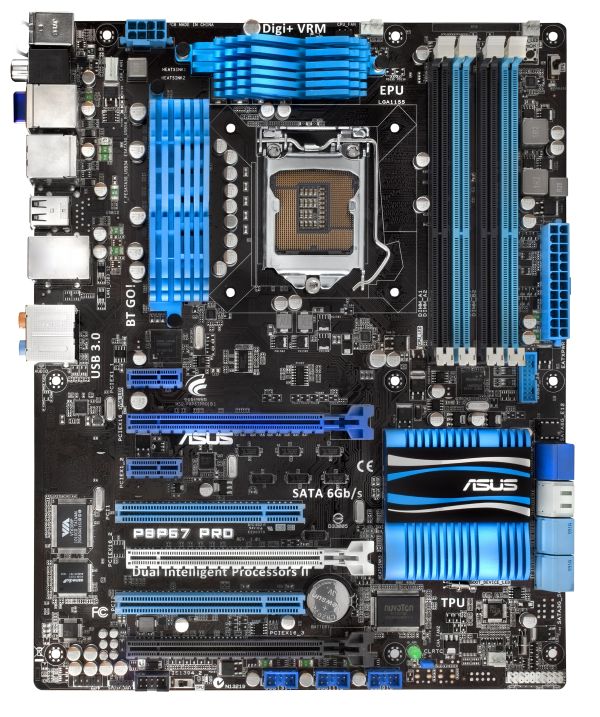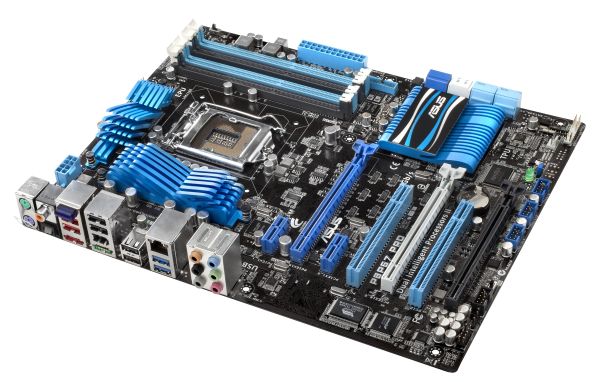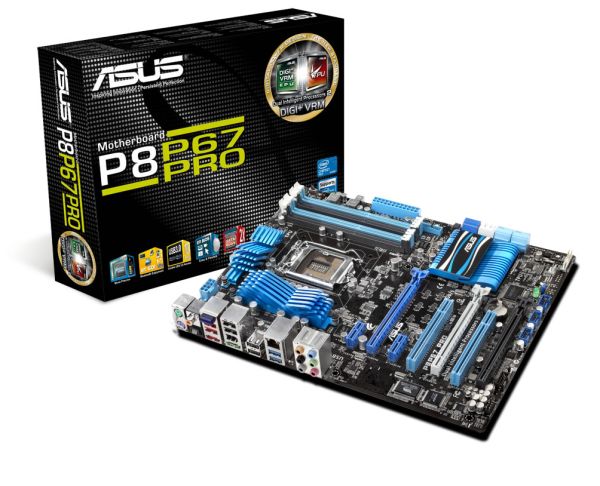The Battle of the P67 Boards - ASUS vs. Gigabyte at $190
by Ian Cutress on January 20, 2011 4:15 PM EST- Posted in
- Motherboards
- Gigabyte
- Asus
- P67
The ASUS P8P67 Pro fits near the beginning of the line-up in the ASUS launch, which in terms of ATX sized boards include the P8P67, the P8P67 Pro, the P8P67 Evo, the P8P67 Deluxe, the Sabertooth P67, the P8P67 WS SuperComputer and the top end Maximus IV Extreme. Therefore, with that in mind, we would expect to be looking at something above the base – slightly more (or better) features than the cheap boards available, enough to warrant the price difference. An overview of the P8P67 series is below:
| P8P67 Series | ||||||
| P8P67 LE | P8P67 | P8P67 PRO | P8P67 EVO | P8P67 Deluxe | ||
| Price | $140 | $160 | $190 | $210 | $235 | |
|
SATA 6 Gb/s SATA 3 Gb/s eSATA |
3 4 1 |
4 4 1 (bracket) |
4 4 2 |
4 4 2 |
4 4 2 |
|
|
CrossFireX SLI |
Yes No |
Yes No |
Yes Yes |
Yes Yes |
Yes Yes |
|
|
USB 3.0 USB 2.0 |
2 14 |
4 (2 via header) 12 |
||||
| LAN | 1 | 1 | 1 | 2 | 2 | |
| Bluetooth | No | Yes | Yes | Yes | Yes | |
Visual Inspection
ASUS have gone with the blue/white/black livery for the Pro board, with a 12+2 digital VRM design covered by slanted blue heat sinks. The socket itself is relatively clear, easily allowing large 1155/1156 CPU coolers to be fitted (remember, 1155 mounting holes are the same as 1156). The CPU fan header is located at roughly one o’clock from the socket itself, with a chassis header to the right of the DIMM slots, presumably for HDD bay type fans.
Next to this header are the EPU switch and the MemOK buttons. The EPU switch enables Energy Processing Unit, which is geared towards saving energy – this encompasses power gating certain features that are never used/used rarely, and declocking when less compute is required. The MemOK button is a physical override for overclocked memory – by holding it down until the red light comes on, at next boot, the UEFI will override the memory settings to something more suitable.
The SATA connectors come in blue (SATA 3 Gb/s), white/grey (SATA 6 Gb/s provided by the chipset) and navy blue (SATA 6 Gb/s provided by a Marvell controller). There is a USB 3.0 header also here, near the DIMM slots. These are all next to the ASUS logo and chipset cooler, which underneath have another chassis header and a green power light. This board is lacking both a debug LED and power/reset buttons on the main board, much to our disappointment.
The PCI slots are well laid out, with a PCIe 1x at the top and enough space between the first two PCIe x16 for a PCI card, meaning that at least one is available if all three PCIe x16 are occupied with dual slot cards. The black PCIe x16 slot is wired up as an x4 slot (as it shares bandwidth with the x1 slots, two USB 3.0 ports and the eSATA ports), and with a dual slot card in there, will cover most of the board USB headers.
The TPU switch is underneath the PCI slots, and performs the same function as the TurboV EVO software in the OS to optimise the system for a decent and stable overclock.
The back panel is standard, with dual PS/2 connectors, SPDIF outputs, USB 2.0 slots, USB 3.0 slots, Firewire, eSATA, audio and Ethernet. The blue module three from the left is the ASUS Bluetooth module, designed to communicate with Bluetooth devices to enhance overclocking or utilise music management. The gigabit Ethernet is handily powered by an Intel chip.














137 Comments
View All Comments
IanCutress - Thursday, January 20, 2011 - link
Long term usability isn't something that's easily tested. Sleep and hibernate is simple to test, but leaving the board on for a week? We unfortunately a) do not have enough hardware to keep the mu;tiples of same test bed and test other products at the same time, and b) if something did go wrong after a long sleep state, how long it would take to get in a different BIOS and re-run the test, or if a new BIOS had been released during the test, the test would have to be restarted. It's not a case of this being ignored by review sites, it's just not an applicable use of time, effort, and sustainability. If this is a major concern to you, then I'd suggest holding back until the next revisions of these boards hit the shelves - by that point, issues would be worked out and there would be a plethora of threads on the vendor's website describing various long term usability issues. There are always niche situations which could be looked at in more detail, and if you're up to the task, join a review website or start your own to tackle these issues specifically.Ian
strikeback03 - Friday, January 21, 2011 - link
Not to say your experiences are isolated (as I have an ASUS board that doesn't like one peripheral when resuming from sleep) but Gigabyte boards can have problems as well. I built a system for work using a P45 Gigabyte board that cannot run for more than 4 days, it just locks up after that.scott967a - Thursday, January 20, 2011 - link
Could you throw an MSI board into the mix?VahnTitrio - Thursday, January 20, 2011 - link
I had to order that ASUS board with basically no reviews available. Looks like I made a solid choice, as I got it for $165. I'm hoping it's waiting for me when I get home from work.landerf - Thursday, January 20, 2011 - link
Does anyone have a break down of what usb/sata controllers each asus model uses?ValueDriven - Thursday, January 20, 2011 - link
Thank you for this article. For me very timely w.r.t. general sandy bridge and ASUS specifically.I recently grabbed an i5-2500K at Microcenter for $192 after-tax, and bundled with an ASUS P8P67 (not PRO, Crossfire only) for another $127 after-tax. For a total of $320. Now all I need is some DDR3 memory and I'll have the missing components for my new build (non-gamer). So for about $375-$400, I'll have for once the basis of a mid-level enthusiast build with the latest technology and over-clockable in the high 4-5GHz range. (I usually trail the technology, letting it "depreciate." Hence, ValueDriven.)
I've had mixed results, but generally good, with ASUS boards. Long ago I had an ASUS P2B-F (i486 I think, PENTIUM III - 750MHz) which seemed pretty good and lasted a long long time.
Next I had an ASUS A7N8X Deluxe (AMD Athlon) board which was OK, although it did finally fail. I only hated it relative to the ABIT NF-7S board I got for a 2nd setup which oc'd a lot better, taking my Athlon from a native 1460MHz up to about 2220MHz..
Most recently I have an ASUS P5 Deluxe WiFi-AP (with a Core2 Quad 6600) which I got on clearance when CompUSA folded (to become kids 'puter). I really can't complain about this board. In fact, it has been great. The only thing it hasn't done is oc my Q6600 as high as I'd like, but I believe this is the fault of my TUNIQ Tower120 which has a crappy mount (press fit screw retainer heads popped off during installation - requiring torch & hammer repair). If I keep this Q6600 setup, I'll probably install a new heatsink...maybe a SCYTHE Mugen 2 w/ double fans which is sitting in the closet. But then I need to get a cooler for the i5-2500k! :(
The only GIGABYTE board I have, a GA-EP45-UD3R, I have never used. I bought it and an INTEL Q9550 for a new build which I'm probably going to skip & resell the parts. But I did buy it b/c I had heard good things about this board. (Mugen was originally for this setup.)
SO for me the real question is: Is it better to keep the Sandy Bridge setup & part out either my unused Q9550 setup or my used Q6600 setup, OR is it better to return the Sandy Bridge and just build my Q9950? The jury is still out!
darckhart - Thursday, January 20, 2011 - link
It's not really value driven if you don't use the parts you buy... it's just a loss. that continues to depreciate.wrt your situation, move forward with the sandy bridge since you have it already. at 4.5+ GHz, and new board features like usb3 etc, it's already loads better than a q9550 oc and p45 chipset.
strikeback03 - Friday, January 21, 2011 - link
I'd have to check, but I believe that is the same processor and motherboard I referenced above. In which case I couldn't recommend it unless you naturally shut the computer down daily or similar. We have it set up next to a stock-clock Q6600/P35 system and the student using them says the Q9550 feels faster, that said if overclocking you probably won't be able to tell much of a difference and the newer parts would probably get you more money back. the i5 is going to be a lot faster.DaveSimmons - Thursday, January 20, 2011 - link
Do any of the three support Dolby Digital Live real-time encoding of game audio as 5.1 for the optical digital port?I'm using analog outs for my socket775 system but may be switching to optical digital for my next build.
ajp_anton - Thursday, January 20, 2011 - link
You should've benchmarked the LAN connection. Is there any difference between Intel and Realtek?